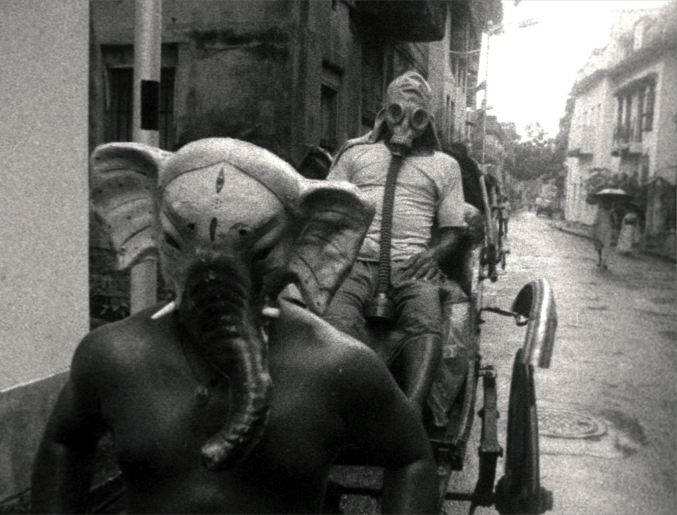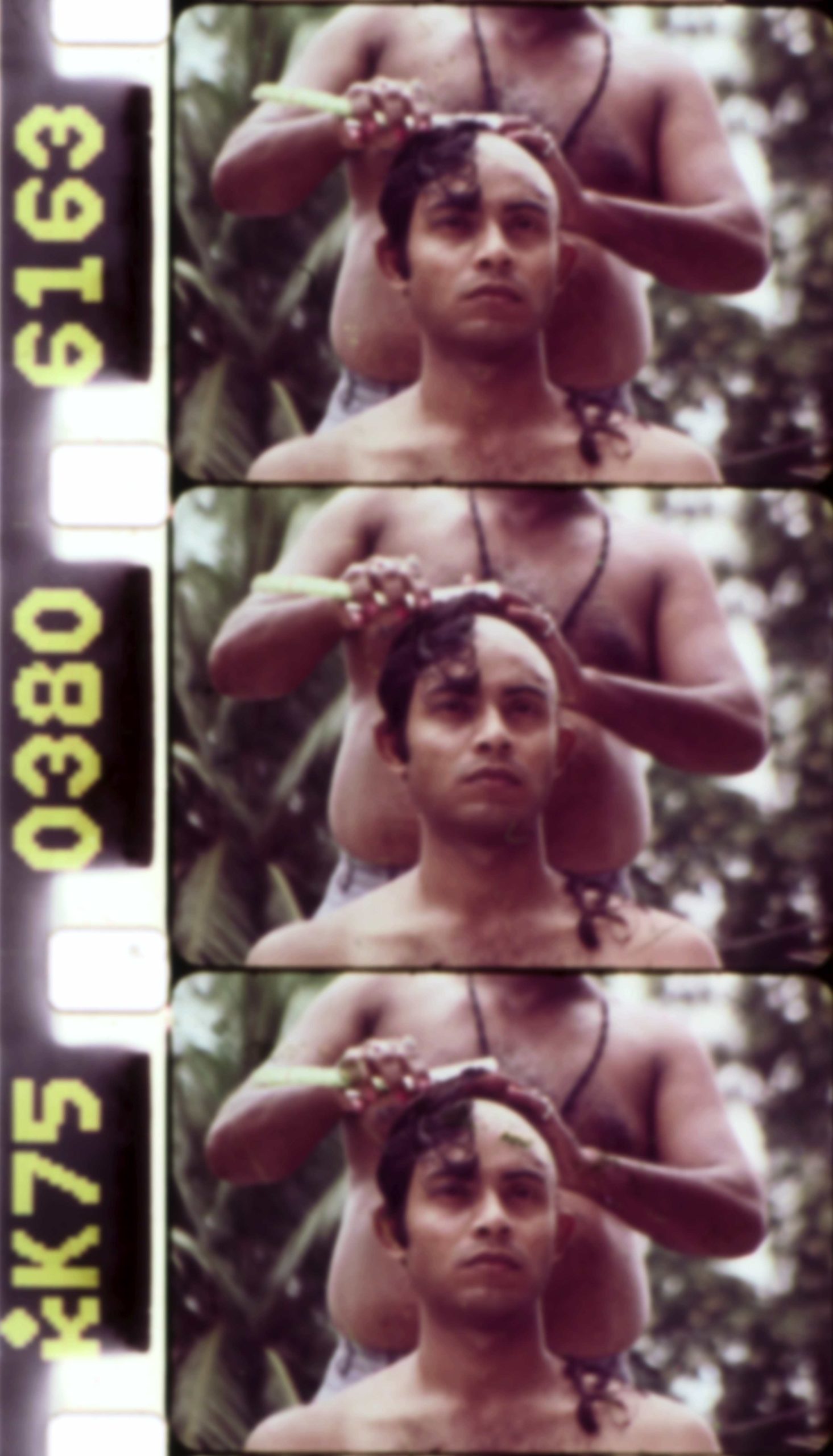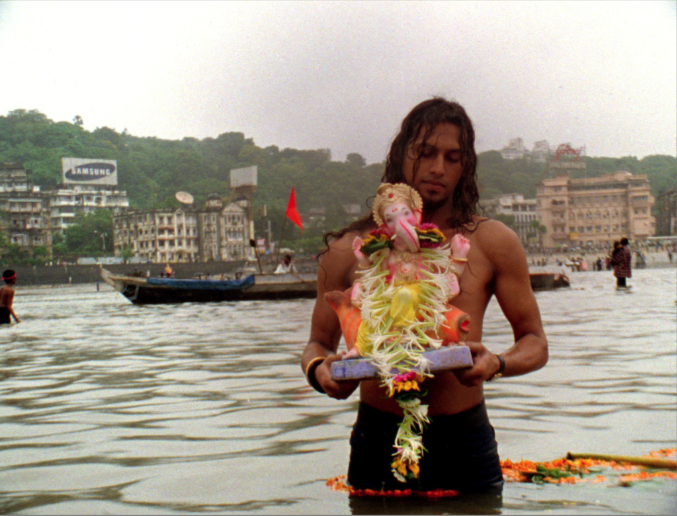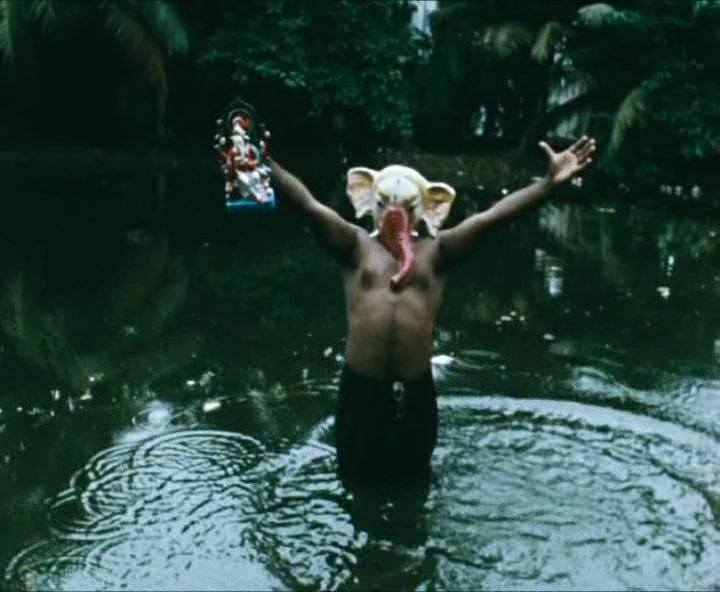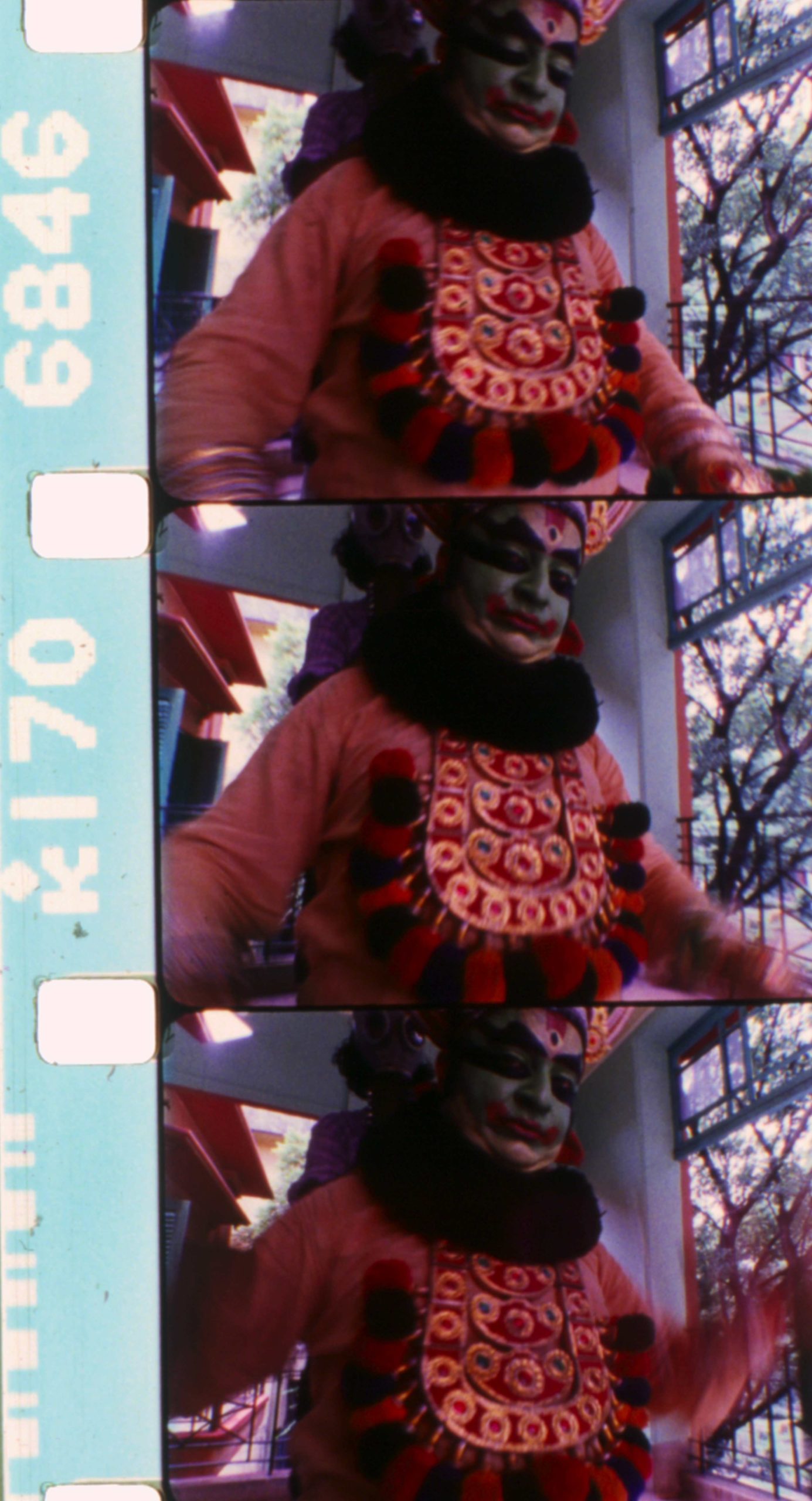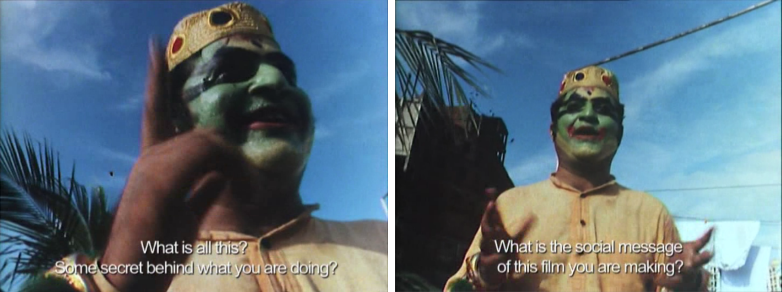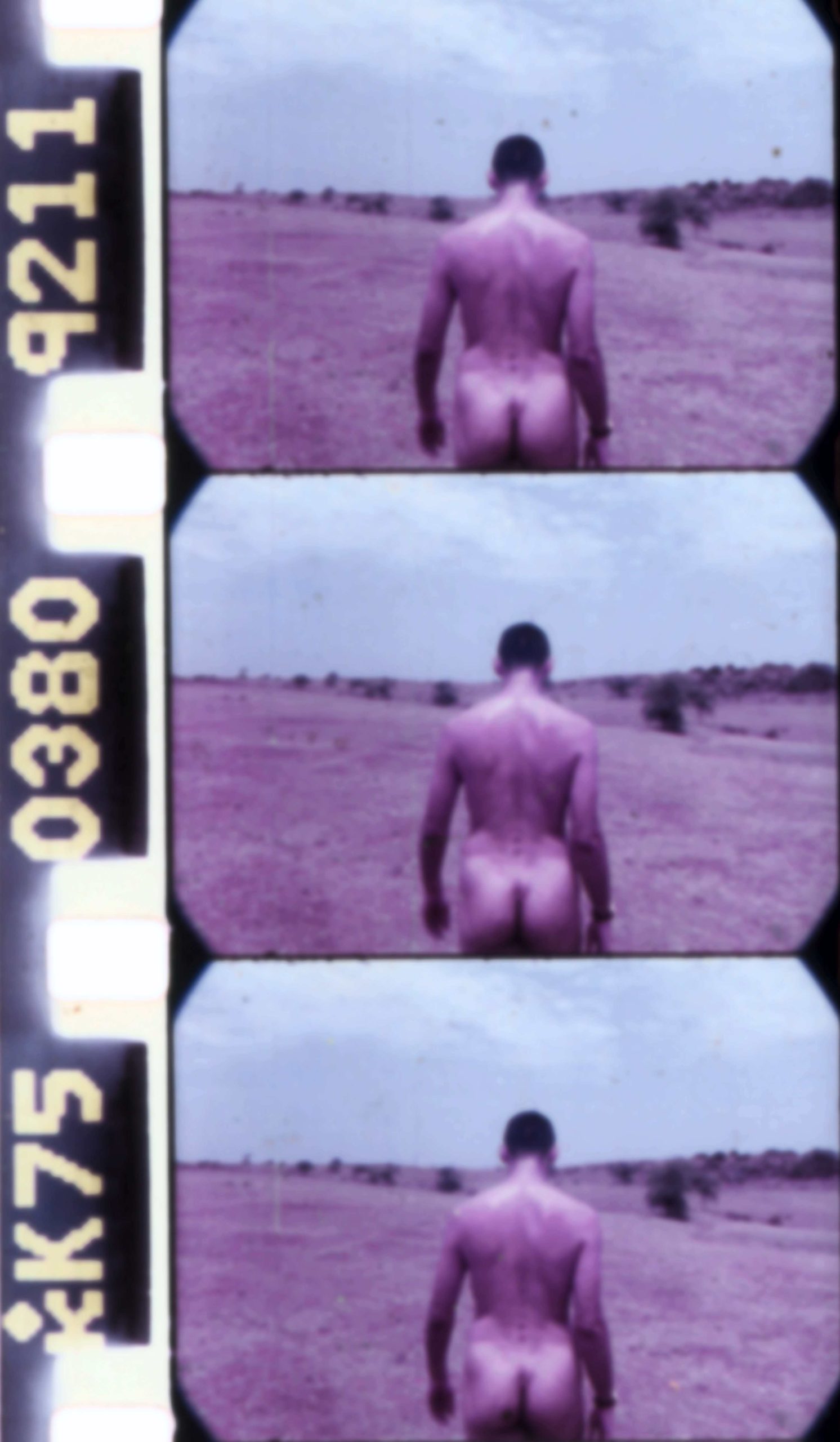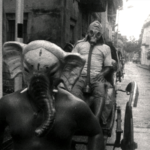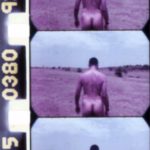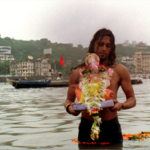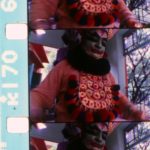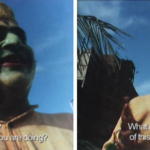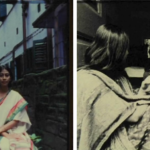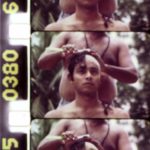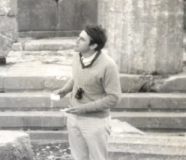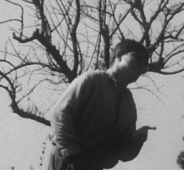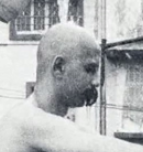Ashish Avikunthak (V.O.)
East by Northwest
“According to his theory, Columbus had to land in India; he discovered America. […] A hypothesis is valid only under the condition that it misses its intended goal, so as to reach another, unknown goal” (Siegfried Kracauer, Ginster).
Similarly, my interview to Indian filmmaker Ashish Avikunthak (b. 1972) starts with a misunderstanding, but it is this very mistake-misstep that triggers the author’s reflection on the poetics and politics of “cinema of religiosity”: thank you Ashish for the trip in terra incognita.
Débordements : The word “mystery” probably derives from a Greek verb meaning “to keep the mouth shut”. If I had to define your short movies in one word, I would say that to me they are “mysterious”: a commentary is almost never provided and to me the meaning of what I see on the screen is elusive because, as a guy totally ignorant about Indian culture, I do not possess the correct “decoding tools” to crack the coded representation by myself.
Ashish Avikunthak : I am not a cryptographer. My films are not about codes that have to be decoded or cracked. I don’t make films like detective stories with a secret. Neither am I a riddle-maker. Your description of my films as “mysterious” is reductive, a product your ignorance, as you have stated. The question betrays your (in)comprehension of unfamiliar cultures as codes to be cracked. Alien cultures are not codes to be cracked: they are worldview to be humbly experienced. You are not to be blamed. Culture as a code to be cracked is a postulation whose historicity goes back many centuries ago, when the West first came in contact with the East. My films are not puzzles that have a correct key or right tools to crack them open. They are experiences that you are drawn into. They are not even about meaning-making, let alone about cryptographic intrusions. They are about being and experience. There is no answer to this mystery. The answer to the riddle is not important. The riddle itself is the answer. The mystery itself is the code. Is it possible to look at my films in this way?
D : It definitely is. Yet, I am curious : why do you reject the explicatory “voice of God” employed in so many ethnographic films in order to provide information, background notions, etc?
AA : Here is another misunderstanding you make in reading of my films : they are not ethnographic films. You are not alone in making that misunderstanding. In 2001, Tampere Film festival gave Kalighat Fetish (1999) the “Best Documentary” award, which I thought was a gross misunderstanding. My films are just films. They do not defy genre or categories, because they exist outside classification. You assume their ethnographic provenance because you read my career as an anthropologist into my films. My work as a cultural anthropologist is far removed from the nature of my filmic oeuvre. My films are not a product of my anthropological research – and my anthropology has nothing to do with films. As an academic, I deal with anthropology of postcolonial bureaucracy and epistemology. I don’t fancy employing cinema as a tool of ethnographic representation : in my view, ethnographic cinema as a project of anthropology is a flawed project. The claim to objectivity, neutrality and ubiquitous recorder of culture was specious, ambitious and epistemologically flawed. The post-structural critique of anthropology effectively muted the objectivism of visual anthropology. My films are not about information and background. They do not have a documentarian impetus. They are films as experiences, therefore they do not need any “voice of God” explication. They don’t need any explication. They are what the viewer imagines them to be.
D : As a spectator, I experienced an uncomfortable yet fascinating sense of mystery in your tetralogy Etcetera (1997), in which we observe a young man walking until he disappears in a desertic landscape (short movie Soliloquy) or in a river (short movie Renunciation).
AA : Those are my first films. They were made between 1995 and 1997, and are a tetratology that is framed by two imperatives. The first imperative is formal: a film in a single shot. Therefore the films are a cinematic exploration of temporality, contemplating the possibility of a cinematic experience that is analogous to the phenomenological Time we experience ontologically. The second impetus was to make films that dealt with philosophical issues. This metaphysical motivation of Etcetera was about the possibility of depicting ritual exercitations within a temporal structure. The four short films in Etcetera seek to examine the various levels at which the reality of human existence functions. In these films, specific ritual exercitations were focused on and their movements contemplated upon, by studying the dynamics of their etymologies. The relationship between the living and the inanimate was the pivot on which the action in the films occurred. These largely mundane actions, prevailing in the vocabulary of daily living, are deliberated upon. Here they were mythized in the context they appear, either as a tonsuring act (short movie Circumcision) or a walk in the cemetery (short movie The Walk). Thus the attempt is to move beyond the creations of grandiose actions to give semiotic credibility to often observed dianural performances, which are neither grand gestures nor major events. The tetralogy was an attempt to comprehend the complexities, subtle and obvious, inherent in these movements. This was constantly emphasized in Etcetera as symbolic poetics and celebrated.
I guess the mystery that you observe is the mystery of life, the mystery of Time and the mystery of the experience of Time. These are temporal films, i.e. films about Time : here the phenomenological experience of Time is employed at the structural framework to articulate the experience of Being. The “mysterious” is your interpretation of the film and it is a valid and an appropriate comprehension of the films but, as I have said earlier, there is no answer to the mystery. The mystery is the answer.
D : Who is your “target audience” and what kind of relation are you trying to establish with your audience?
AA : I don’t work with an idea of an audience. Neither am I trying to establish a relationship with the audience. I don’t make films for an audience, or “target audience”. I don’t believe in the idea of catering to an audience. As a matter of fact, I don’t believe in the idea of “the audience”. This is the politics of my theory of practice. The idea of the audience is very closely linked to the relationship between cinema and capital. The history of cinema is symbiotically associated to capital, because cinema’s mode of production is capital-intensive. The need for an audience was essential because not only the capital used to produce the film had to be recovered, but also a surplus (profit) had to be produced. In such a system of cinematic production the idea of the audience is imperative. Here the relationship between cinema and audience is mediated by capital. Such a capital-mediated relationship between any work (art, cinema, literature, etcetera) and its consumer is fundamentally problematic for me. Such a relationship works well with cinema as entertainment. I make films that are self-produced and I do not see these works as a way of accumulating surplus capital. I do not see my films as commodities that circulate in the world of capital. I see them as autonomous pieces of work that can exist irrespective of circuits of capital. It is this idea of a cinematic work devoid of its dependence on flow of capital and finances that drives my practice of art production. In this mode of production the audience for me is not a consideration.
D : I read that you coined the expression “cinema of religiosity” to describe your films. What do you mean exactly by “cinema of religiosity”? To me, the term “religiosity” evokes something “secret” that only “initiate” people can understand…
AA : Religion is not a secret practice. It is viewed as secretive or mysterious for those who are outside it. Similarly, the sacrosanctity of a ceremony is only mysterious to those who are not part of it. A ritual is not inherently secretive or mysterious. So again I would resist your comprehension of my films within a cryptographic metaphorical framework. Your understanding of my films, as I have mentioned earlier, emerges from your viewing them as the cultural product of the ethnographic Other. In such a context you would be lost. You are searching for meaning or a code where none exists. Perhaps your non-understanding is the very code to experience my films. As I said earlier, the secret is the code. The mysterious is the code. The secret is not important. The important thing is that the secret exists. To know it is not important. It is just important to experience it.
By “cinema of religiosity” I mean a cinematic experience that is seeped in the ontology of religious experience. An experience that is analogous to a visit to a temple – a film that is about a religious experience and not about narrative. This, I would argue, has been true at the birth of Indian cinema, especially in the context of D.G. Phalke’s films. Here cinema was indeed a religious experience. They have been erroneously classified as “mythological”. I would categorize them as “cinema of religiosity”, because the very act of viewing the films is a religious act. For me cinema of religiosity is about a theory of practice – about the act of ritual, devoid of doctrinal exegesis. I think of my work with Kalighat Fetish (1999) as a process through which I have explored my own religiosity. It is a process that started with the films in Etcetera, which are essential exploration of existence through a contemplation of the ritual. In Etcetera rituals are secular : they are bereft of any religious connotation, but exist in a universal spiritual and philosophical perception. It is with Kalighat Fetish that I find ritual in religious context helping me with the exploration of existence through a contemplation of the ritual. It was an intuitive process, and then with Vakratunda Swaha (2010) it was a more conscious process. Vakratunda Swaha began as requiem to a dead friend, Girish Dahiwale, and it ended as a theology on death. From an elegy it was transformed into a ritual. The allegory of double death is the emblematic kernel of the film : the ceremonial sacrifice of Ganesh in devotional fervor for the inevitable resurrection, and the irreversible death of Girish never to be resurrected. The devotee is dead but the divine is re-born. The tension between certitude of the death and the redemption of reincarnation forms the theological imperative of the film. For me this becomes a cinema of religiosity. This is taken to another level with my feature film Katho Upanishad (2011) and continues with my most recent film Rati Chakravyuh (2013), and in two more subsequent untiltled feature length films which are currently under production.
D : I found your short movie Dancing Othello particularly thought-provoking. Throughout the film Arjun Raina functions as our Indian “guide/host”. Suddendly, at the end of the film, the afore mentioned “cultural mediator” accuse you – the director of the movie – of misrepresenting Indian culture : he says you didn’t explain things clearly, that you showed no story nor “social message”. Arjun Raina is playing a part in the movie (the part of Peter Pillai), but did you ever actually receive such criticism?
AA : Arjun Raina is not playing a part in the film : Arjun Raina is playing himself. The film was not planned or enacted with a scripted dialogue. The dialogue was organically performed in front of the camera as a response to the film we were working on. This was the last shot of the three days shoot of the film. It was Arjun response to the practice of my filmmaking. It was a spontaneous criticism that was captured on film. Arjun Raina as Peter Pillai is critical of the critic. The critic as audience seeing the film is the ultimate irony. The postcolonial critic himself is the most ironical figure. In this last section of the film, “Arjun Raina the actor” and “Peter Pillai the character in the film” become one. And their diatribe against the film and the director of the film is the critique of the filmmaking process. I think this self-reflexive moment is the most important part of the film : it is the auto-critique. The film is simultaneously lost and resuscitated in this auto-critique. Here the film collapses within its hypercritical self-reflection, however it is in this collapse that the postcolonial recovery is possible.
You see, during the shooting of this shot the 16 mm roll of negative ran out, but Arjun kept on talking. I told my cameraman not to stop. We knew that nothing was being recorded except the sound. Arjun did not know that the negative had run out, so he kept going on. I was looking at my watch and he retorted to my actions impulsively. It’s a very visceral response to the act of filmmaking therefore it becomes very self-reflexive. That’s how the film ends : the film ends at the moment of auto-critique.
D : The core of Dancing Othello consists in the clash between Shakespeare’s monologues and Kathakali dance, both forms of storytelling performed by actor Arjun Raina. How did this project come about ? Why did you choose to mix Kathakali with Shakespeare’s Othello ? Why did you choose Arjun Raina as performer?
AA : Dancing Othello began serendipitously. I was studying in Stanford University when Arjun Raina, the only actor in the film, was touring United States. He came to Stanford with his show in the Spring of 2001. He was staging The Magic Hour, an experimental mix of Kathakali, Shakespeare and Khelkali (a form of street and folk theater act). The show juxtaposed Shakespeare narrativity with the complex stylization and esoteric theatricality of Kathakali and with an improvisational performance to create an idiosyncratic theatrical idiom – a hybrid between the East and the West, the classical and the profane, the profound and the frivolous. I was completely blown away by the performance. I knew of Arjun because he had acted in a cult English language film in India (probably the first postcolonial) written by Arundhati Roy – In Which Annie Gives It Those Ones (1989). This is a delicate black comedy made by Pradip Krishen and it recounts Roy’s autobiographical experiences while studying at the School of Planning and Architecture in New Delhi. I saw the film as a teenager on the State-run television and remembered Arjun from those days. During my interaction with Arjun soon after the show at Stanford, I instinctively asked him if he was interested in collaborating on a film about his performance. I wanted to make a film that centered on pieces that he formed at Stanford: scenes from Othello and A Midsummer Night’s Dream, and the eccentricity of the Peter Pillai character.
I explained that we’d shoot the film in Calcutta on 16 mm, however I’d not be able to pay him anything. He generously agreed to be part of the project. He came to Calcutta in the summer of 2001 and we shot the film in three days. I shot mostly at my house in Calcutta, the house where I was raised. At these locations I asked Arjun to perform whatever he preferred and we let the energy of the location determine the chemistry of the performance. The film did not have a script and we worked intuitively. Almost all my films are made in this way – scriptlessness is an intuitive form of practice. There are some ideas but there is no definite script, and then you start painting with film, letting the idea, the location, the actor’s energy, the crew’s mood effect your next strategy. So it’s a very spontaneous film practice, it’s not planned in any sense. You can really say Dancing Othello just happened : a series of coincidence, some ideas, a bit of collaboration and a lot of intuition.
D : Probably, with Othello, Shakespeare meant to create a tragic figure whose feelings early 17th Century Englishmen could understand and empathize with in spite of the color of his skin. Today, in a post-colonial frame of mind, Othello can also be seen as a tragic hero in his effort to integrate among the masters and be one of them. Whatever the case, is there a similar figure in traditional or modern Indian narratives (novels, poems, plays, films, tv shows…)?
AA : There are hybrid figures like Othello in Indian epic and Purnanic traditions, figures of demons who are like Gods. One of the most profoundly popular examples is that of Ravana from Ramayana, the ambiguous dark figure, who is tragically villainous. However, for me Othello is not important in itself, it is rather the irony of the Dancing Othello that is crucial to the film. Here Shakespearean Othello dances as a Kathakali performer. This amalgamation is important to understand. Kathakali in postcolonial India is a national dance form, a classical dance form. It is viewed as secular and devoid of its religious core. This admixture is the essence of the postcolony. The combination of Kathakali and Shakespeare is symbolically important in postcolonial India for it marks the moment when the imperial status of Shakespeare is finally domesticated by the “savage” art form of the Orient. Politically, this becomes a significant act. This exemplifies Homi Bhabha’s idea of the hybrid. In this process both Shakespeare and Kathakali are transformed. A hybrid performance is born, merging the epitome of English literature and the quintessence of Indian art. The actor shatters the traditional and conventional practice of Kathakali, by introducing Shakespeare as the narrative focus of the dance form. Here Shakespearean narrative is de/reconstructed by the classical dexterity of Kathakali and simultaneously the classical traditionalism of Kathakali is also de/reconstructed by Shakespearean dramatics.
D : Talking about de/reconstruction, in your film Antaral (End Note) (2005), the point of departure is Samuel Beckett’s “dramaticule” Come and Go. How and why did you get interested in Beckett’s theater?
AA : I came to know about Samuel Beckett’s work like most people in India through his iconic play Waiting for Godot. I saw it when I was in college in Bombay, and soon after I read most of his plays. I particularly enjoyed his shorter plays because of his ability to produce philosophically profound works with a strong sense of brevity and sparseness. The complexity of the minimalist narrative mesmerized me when I read the play for the first time. I was struck by the succinct nature of the narrative. I am also easily seduced by the formal. I was seduced by Come and Go because of its formal structure, rigor and succinctness. The magic of a succinct, formal structure, with its metaphysical genealogy was hugely appealing. In this play I see a deep-seated aura of grief, an unfathomable sadness – an unsaid despair that is evocative, that is moving and that is intensely emotional. The affect of the cyclical, the expressive emotional in the repetitive and the infinite depth of such a dramaticule gripped me very forcefully. However, I did not want to make a film that simply mimicked the structure that Beckett had constructed. I wanted to experiment with the narrative. I wanted to fragment it; to rupture it; to produce an ambiguous emotion. I wanted to push the polysemic narrative intrinsic to the play to further disenchantment. For me this film is about remembrance, said and unsaid; about reminiscence of forgotten places and elapsed times; about rekindled friendship and unrequited love; and finally about trauma of failed relationships. Antaral is both recourse to memory and discourse about memory. It is a film that delves into the ambiguous crevices of past scrounging to comprehend its meaning, but emerges empty-handed. The film ambivalently explores the effervescent intrusion of past on the subjectivity, spatiality and society within which the contemporary not only exists but also reconstitute itself. It struggles to remember in order to reconfigure its own present but is confronted with nothing but silences of history : history of the self, the city and the community. This film for me is not only an exploration of memory, past and trauma, but it is about love, intimacy and friendship. It is about the haunting melancholia of unsure relationships – of love that is unrequited, unexplained and probably lost. This is at once a film about me, my family, my neighborhood and my city Calcutta.
D : Generally speaking, how would you define the work on Western plays you did in Dancing Othello and Antaral ? Appropriation? Adaptation?
AA : I would not define it as appropriation or adaption. I would rather call it “reconfiguration”, that is to say a work in which I invoke the essence of the original text but reframe it within a cultural, ideological and personal framework of my own provenance. Here the essence of the text is retained, but I profoundly shift its structural configuration. I employ the original text to leap frog into creating my own universe. It is a form of ideational hitchhiking. The original text is one of the many vehicles I jump on into my own creative journey. This is the strategy that I use with any text that I work with and not confined to Western plays. I employ this reconfiguration strategy in my feature films, too. My first feature film (Shadows Formless, 2007) is inspired by Malayalam novella (Pandavapuram by Setu) and my second feature film (Katho Upanishad, 2011) is based on 6th Century BCE Sanskrit philosophical text.
D : You raised the issue of film and memory. In Rummaging for Pasts (2002), you almost literally become an archaeologist by digging out super 8 footage from a junkyard. Can you tell me more about this experience?
AA : Rummaging for Pasts : Excavating Sicily, Digging Bombay is a film that has two origins. The first is my training as an archaeologist, that eventually took me to Stanford University where I did my doctoral work on anthropology of archaeology, especially in the context of how archaeologists create meaning about the past. This film is one of the many pit stops of this scholarly journey of mine. In the summer of 2000, I was part of an international archaeological project excavating at an enigmatic site of Monte Polizzo, Sicily. During my stay there, I made a video diary, which was driven by my own subjectivity of being the only colored archaeologist in an international team of Americans and Europeans. The second origin of the film emerges from my own work as a collector of Indian homes movies (16mm, 8mm and super 8), which I have been collecting since the mid 1990s from a flea market in Bombay. This film is a merger of both these practices of my life. This film is an experimental juxtaposition of two cinematic documents: the video diary of an international excavation and found footage from Indian home movies. The archaeologists, digging on the site of Monte Polizzo are in pursuit of an ephemeral past, its people and its meaning; the found footage, literally excavated from a roadside junkyard in a Bombay flea market, embodies forgotten images of a collective memory. Two archaeologies are at work: one is an academic endeavor, the other a collector’s fetish; one is investigating the pre-classical world of the Mediterranean in search of the indigenous Sicilian, the other is a gaze into the private moments, ceremonies and rituals of urban middle-class India of the 1970s. The film is an attempt to engage with the ambiguity inherent to the rumination over these pasts, once abandoned and now reconstructed, assuming fresh connotations and meaning. The multiple objectives of the archaeological endeavor coalesce with the palpable visuals of a brief nostalgia to emerge as a continuous narrative.
D : In your opinion, does digital video nowadays function like the small-format film you collect?
AA : The introduction of small format (16 mm in 1923 and 8 mm in 1932) was the first democratization of the cinema technology – a phenomenon that has been recurring. The rise of the Video VHS, followed by the digital video, DSLR and now the latest 1080p video enabled cell phone are similar steps. Each transformation has made cinema democratic. Each step has made the technology less cumbersome and easy for novices to use. Each step allowed new creators to participate in the film making process. The simple answer to your question is yes digital video is a technological mimesis of the small format 8 mm & 16 mm. However there is a distinction I would like to underscore. There is dissimilarity that is at the heart of the technological ideology of these two mediums, and which has given birth to different kinds of moving images. The most profound difference is that 16mm / 8 mm /super 8 are filmic medium; intrinsic to that technology is a theory of practice of constraint and discipline. In contrast, video is an unfettered medium. This unbounded technology in sharp divergence has given birth to new form of cinema. Specifically with the rise of non-tape digital medium, ubiquitous cinema has emerged. This is inescapable cinema. This is omnipresent and omniscient cinema. It is ever present and forever existing. Its logical conclusion is the surveillance world of CCTV that records everything, everywhere and forever. Digital video for me is robotic, detached, distant and almost immortal. In contrast the film (8mm/16mm and 35mm) is ephemeral cinema. It has limitation, it has restraints, it has inadequacies, it is imperfect, it changes over time, it even can die out – this for me makes film more delicate, emotional and even human.
D : And why do you collect these home movies?
AA : Small format (16 mm / 8mm) was introduced into the market specifically for amateurs to make films without much technical know-how. The idea was to produce a format that was portable and less complicated which allowed for greater flexibility and compatibility. Such a filmic intervention for the first time was able to penetrate the zone of the private in an inconspicuous way. This format gave birth to cinema of the private spectacle. Like early cinema which was interested in capturing anything that moved or seemed unusually spectacular, the small format captured the spectacle in the intimate domain – weddings, birthdays, ceremonies, outings, tourist visits and even private sex acts. The personal became the spectacular. The intimate was the new attraction. Here the private became public. This I would argue made home movies the earliest sites of autoethnography in cinema. The auto portrait is the most genuine ethnography. Here in the forms of personal memories, the daily practices of everyday life of the self were captured. In a stunning way the self and the private world of the self became the center of the cinematic spectacle. This form of cinema was banal but it was very widespread. It was marginal in the public sphere but it was a dominant form of intimate cinematic practice. This form of cinema also gave birth to the cinema of the self, whose logical conclusion is seen in Youtube. The only difference between 8 mm home movies and Youtube videos is the massive distributive capacity of the Internet. The public of the private world of 8 mm home movies was still within the domains of the familial, whereas in the case of the Youtube the whole world has access to the private world of the self. The self has finally become globally public. To understand this idea of the private self in the global public sphere it is imperative to go to its earliest moment in cinema and that are these small format home movies. For me this collection is not a fetish. This is not nostalgia. Neither is this an insular academic activity. It is practice of remembering. Reminiscing private memories of unknown persons before they are forgotten. They are like private letters written to lovers, daughters, sons, wives and husbands that do not have communal value, but are inundated with intimacies and affect that move us. In the history of cinema, which is overwhelmingly public these are signpost of the personal.
D : From an ontologic point of view, film medium has often been associated to an “embalming of Time”, a technology of death and resurrection. What’s your take on this subject? Are you interested in this almost “magical” power of moving images?
AA : Early cinema has been called “cinema of attraction”, thus highlighting that intrinsic quality of moving images that had the quality of miracle. The ontology of its movement was the miracle. A cinema that was not yet under the hegemony of narrative but still had the charm of astonishment. This cinema was fundamentally ontological. Here the ontology of movement was more captivating than the epistemology of the narrative. It was cinema that had the ability to surprise. This is magical cinema – that can amaze, shock and cause bewilderment. This form of cinema has had a deep fondness for me and I would say had informed a large part of my cinematic work. This emerged organically as theory of practice rather than an intellectual engagement with the history of cinema. I don’t think myself as a conceptual artist, rather a filmmaker who still believes in a cinematic experience that has not been weighed under the burden of narrative. Therefore for me temporality plays a key-role in my cinematic practice. Cinema for me is the only representational practice that has the possibility of making time malleable.
More than “embalming of time”, I think of cinema as “conjuring with time” or, as Andrei Tarkovsky, would say “sculpting with time”, but with a hint of the magical potential of Georges Méliès’ maya (Sanskrit word for “illusion”). Or, specifically, in the context of my work as cinema of religiosity, I think of cinema as the illusion-play with temporality. For me it all began with the emancipatory possibility of a man walking nude in a desert for 400 feet (short movie “Soliloquy” in Etcetera) to the divine miracle (maya) of the man with the gas mask walking forward with the world going in reverse (Vakratunda Swaha) – almost magically rupturing through the sinews of Time itself.
All the images are coming from Ashish Avikunthak's films : Vakratunda Swaha (2010) / Etcetera (1997) 16 mm film strip / Vakratunda Swaha / Dancing Othello (2001) - 16 mm film strip and two images from the movie / Antaral (End Note) (2005) / Etcetera.
